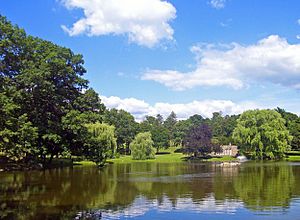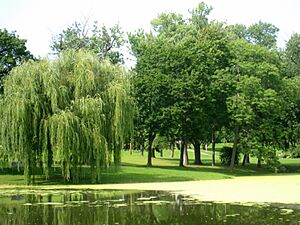Downing Park (Newburgh, New York) facts for kids
Quick facts for kids Downing Park |
|
|---|---|

The pond and fountain, known as the polly
|
|
| Type | public park |
| Location | Newburgh, NY, United States |
| Area | 35 acres (14 ha) |
| Created | 1897 |
| Operated by | Downing Park Planning Committee, City of Newburgh |
Downing Park is the biggest public park in Newburgh, New York. It was designed in the late 1800s by two famous landscape architects, Frederick Law Olmsted and Calvert Vaux. They gave their design to the city with one special request: the park had to be named after their mentor, Andrew Jackson Downing. He was from Newburgh and sadly passed away in a steamboat accident on the Hudson River in 1852.
History of Downing Park
Most of Downing Park used to be a farm owned by the Smith family. Their old farmhouse, built in the 1750s, was where the pergola stands today. The idea for a park came from Mayor Benjamin B. Odell in the late 1880s.
The city bought the 25-acre Smith farm and later added 10 more acres. The city asked Olmsted and Vaux to design the park. They gave their plans in 1889. This was the last time these two famous designers worked together.
Vaux and Olmsted were known for creating open spaces that helped people feel good. They liked natural, wild, and curvy designs for landscapes. Downing Park, with its 35 acres, was planned to be a calm and peaceful place in the middle of the city. Building the park started in 1894, and it opened in 1897.
When it first opened, the park had the farmhouse, an observatory, and a band shell. The observatory was designed by Calvert's son, Downing Vaux. It sat on the highest spot in the park, offering amazing views of the Hudson River. The farmhouse was later used for other purposes. In 1908, it was taken down. Later that year, architect Frank Estabrook designed the pergola to be built on the old farmhouse's foundations. The band shell was removed in the 1920s. The observatory was taken down in 1961 as part of a city improvement project.
Downing Park Today
Downing Park is right in the center of Newburgh. It is located between Robinson Avenue (US 9W-NY 32) on the west, South Street on the north, Dubois Street on the east, and Third Street to the south. Carpenter Avenue divides the park into two halves.
The most famous part of the park is the pond and fountain in its southwest corner. It is known as the "polly." In the early 1900s, people loved to go ice skating there in winter. Now, skating is not allowed because the water doesn't freeze well enough due to pollution. The Polly’s natural stone Shelter House was added in 1934. It was designed by local architect Gordon Marvel. It used to be a place for visitors to change into skates and drink hot chocolate. Today, it is the office for the Downing Park Planning Committee.
To the east, the land goes up to a small hill called the terrace. From here, you can see the Hudson River. The park also has an amphitheater to the north of the polly. Many local concerts and festivals happen there in the summer.
Plants and Animals
Downing Park has the only special daylily garden in New York. It was given and is cared for by the Iris and Daylily Society. You can often see a blue heron fishing in the two-and-a-half-acre Polly pond. A great white heron has also been spotted there. Other animals you might see include brown mallards, wood ducks, snapping turtles, peregrine falcons, and visiting Canada geese.
Events at the Park
Downing Park hosts many fun events. The Newburgh Farmers' Market is held here from July through October. There is also an annual Tuskegee Airmen's Family Day and an annual Easter Egg Hunt. The Greater Newburgh Symphony Orchestra also holds free Summer Pops Concerts at Downing Park.


